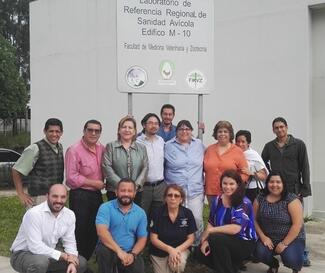Collaboration strengthens canine rabies control in Guatemala
- Community News
- Dog vaccination
The Universidad del Valle of Guatemala (UVG), CDC-Central America Region Office, and the Centers for Disease Control and Prevention (CDC) have collaborated for several years to enhance surveillance and improve the current understanding of rabies risk in Guatemala. These collaborations have resulted in the coordination of a workshop for the Stepwise Approach to Rabies Elimination (SARE) in 2016, where the current rabies situation was analyzed by key program leaders. The SARE was conducted with the help of the Poxvirus and Rabies branch from the CDC and included two days of evaluation and a half day of presenting and discussing results.
One of the more prominent outcomes of the SARE was the creation of the National Rabies Working Group for Guatemala. The group now has monthly meetings to provide technical and scientific support to the National Zoonosis Program that is coordinating Guatemala’s canine rabies control efforts. Following the SARE workshop, as a first step to help improve canine rabies control and elimination, a post-vaccination evaluation was conducted in several locations to determine if adequate rabies vaccination coverage was being reached in the free roaming dog population. For this survey, canine rabies vaccination practices and basic animal ownership characteristics among the community were assessed using a questionnaire that was given to dog owners bringing their dogs to the vaccination post. Vaccinated dogs were marked with a blue collar.
The vaccinated population was estimated the day after each vaccination campaign in the study areas using the methods previously conducted and validated in Haiti by CDC. The methods included rapid community dog assessments and sight/re-sight surveys. For these surveys, CES-UVG staff (researchers and field technicians), veterinarian students from the National Veterinary School of San Carlos University, undergraduate students, and students from the veterinary masters program were trained in the field by the CDC staff.
The survey data was compared to the official dog population data used by the Ministry of Health for planning vaccination campaigns and calculating the vaccination coverage. The survey results estimated that the official vaccination coverage has historically been overestimated in the free roaming dog population. From the survey data, it was concluded that the campaign covered around 40% of the dog population in that area, compared to previous reports of >70% rabies vaccination coverage.
For follow-up purposes and to identify the reasons why dog owners do not take their dogs to the vaccination campaign, a door-to-door survey was conducted four weeks after the campaign, and the results revealed several different barriers for owners not taking their dogs to the campaigns. The main reason was poor communication and the lack of advertising about the vaccination campaign. With these results, the local health staff in charge of the vaccination campaigns decided to put in extra effort to reach the anticipated 70% coverage levels and went door-to-door vaccinating dogs in order to reach their goal.
In the follow up survey conducted by CES-UVG, it was also determined that despite these extra efforts, the campaign did not reach the 70% coverage required. This is mainly due to the underestimation of the actual dog population. The results were reported to the national zoonosis program, and discussions about how to implement the dog surveys before the next campaign are in process.
Currently, we are training more veterinary students, and expanding dog population surveys to four sites in different departments in the country: Zacapa, in the east, Sololá and Sacatepéquez, in the center, and Huehuetenango, in the highlands of the west, areas where the more recent human rabies cases were reported in the last half of 2016 and early 2017. The next steps will be to expand the pilot survey to several places around the country, train more veterinary and public health students, and the personnel of the zoonosis program, to conduct these surveys as a way to strength the canine rabies control efforts in Guatemala.
Contributed by David Moran from the Universidad del Valle of Guatemala, on behalf of the team.

